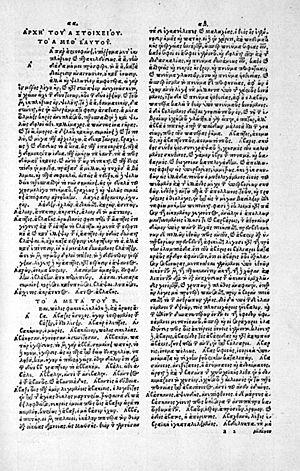Suda facts for kids
The Suda (pronounced Soo-dah) is a huge encyclopedia from the 10th century. It was created in the Byzantine Empire, which was a powerful empire in the eastern Mediterranean. This amazing book is like a giant dictionary, written in Greek. It has about 30,000 entries!
The name Suda probably comes from a Greek word meaning 'fortress' or 'stronghold'. This name fits well because the book is a strong collection of knowledge. It helps us understand the ancient Mediterranean world.
The Suda is a mix between a dictionary and an encyclopedia. It explains where words come from and what they mean. But its most valuable parts are the articles about writers and their works. These sections often share details and quotes from authors whose other writings are now lost.
This book was a handy reference for people important in politics, religion, and literature. It covered history in the East up to the 10th century. One of its main sources was an encyclopedia by Constantine VII, a Byzantine emperor. For Roman history, it used writings from John of Antioch.
The Suda includes topics from the Bible and from ancient pagan beliefs. This suggests that the person who wrote it was likely a Christian. While some parts might not be perfect, the Suda still gives us lots of information about ancient history and daily life.
How the Suda is Organized
The Suda is mostly arranged like an alphabet. But it has a small difference! The letters follow the sounds they make, similar to how modern Greek is spoken. This system is easy to learn once you get used to it. Some newer versions of the Suda have been rearranged to be in a more standard alphabetical order.
See also
 In Spanish: Suda para niños
In Spanish: Suda para niños


